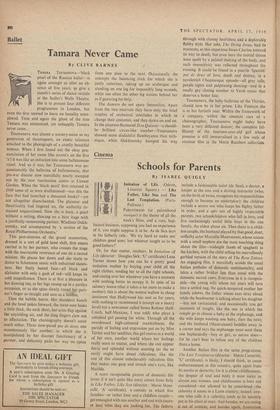Ballet
Tamara Never Came
By CLIVE BARNES
TAMARA TOUMANOVA—`black pearl of the Russian ballet'—is again amongst us after an ab- sence of five years, to give a month's series of dance recitals at the Sadler's Wells Theatre. She is to present four different programmes in London, but even the .first seemed to leave no banality unex- plored. Time and again the ghost of the true Tamara was announced, yet unhappily Tamara never came.
Toumanova was almost a nursery-name to my generation of theatregoers, an exotic talisman attached to the photograph of a cruelly beautiful woman. When I first found out the okay pro- nunciation of her name (the accent's on the first `a') it was like an initiation into some balletomane ritual. And so it was, for Toumanova was un- questionably the ballerina of balletomania, that pre-war disease now mercifully nearly stamped out by the new vaccination centre at Covent Garden. When the 'black pearl' first returned in 1949 some of us were disillusioned—was this the face that had launched a thousand. books?—yet not altogether disenchanted. The glamour and theatricality had lingered on, the authority re- mained unquestioned. Now she is back, a pearl without a setting, dancing on a bare "stage with a justifiably unassuming partner, Wladimir Oukh- tomsky, and accompanied by 'a section of 'the Royal Philharmonic Orchestra.'
This past-mistress. of the grand mannerism, dressed in a sort of gold lama' shift, first enters carried in by her partner, who crosses the stage with the inscrutable reverence of one on a sacred mission. He places her down and she• starts to dance to Schumann music with unhurried snooti- ness. Her finely boned face—all black and alabaster with only a gash of red—still keeps its cold magnificence. There is at first a pleasure in her dancing too, as her legs swoop up in a perfect extension, or as she spins slowly round her part- ner's finger as straight and sure. as a bottin.
Then the bubble bursts. Her shoulders hunch and the head pokes forward, the torso now looks a little thick, the neck short, her arms flap against the unyielding air, and the long fingers claw out to affectation. The choreography doesn't assist much either. Three slow-paced pas de deux, one monotonously like another, in which she is manipulated by her discreet functionary of a partner, and delicately picks her way on tiptoe from one pose to the next. Occasionally she attempts the balancing trick for which she is justly notorious, taking up an arabesque and standing on one leg for impossibly long seconds, while too often the other leg wavers behind her as if gesturing for help. The dancers do not spare themselfives. Apart from the two intervals they have only the brief respites of orchestral interludes in which to change their costumes, and they dance on and on. In the pimento-flavoured Don QuixOte—a should- be brilliant circus-like number—Toumanova showed more disdainful flamboyance than tech- nique, while Oukhtomsky bumped his way through with clumsy healtiness and a deplorably flabby style. Her solo, The Dying Swan, had its moments, as this imperious Swan-Czarina tottered its way to death, but even here the mortal throes were spoilt by'a palsied shaking of the body, and such insensitivity was reflected throughout the evening. It could be found in a puerile 'Spanish' pas de deux of love, death and destiny, in a novelettish Chopinesque episode—all grey tulle, purple tights and palpitating dancing—and in a madly gay closing number to Verdi music that deserves a better fate.
Toumanova, the baby-ballerina of the Thirties, should now be in her prime. Like Fonteyn she is in her fortieth year. Within the framework of a company, within the constant care of a choreographer, Toumanova might today have been a very different dancer; the complete ful- filment of the fourteen-year-old girl whose promise is still immortalised in a few reels of amateur film in the Marie Rambert collection.


































 Previous page
Previous page